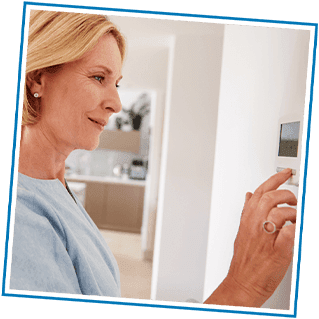
Efficiency With A Plus HVAC & Electrical
Westfield Radiant Floor Heating
Radiant floor heating can be called the silent hero of home heating. Since the heat actually emanates from the floor, it is efficient and quiet, without blowing allergens throughout a home’s air. It’s not drafty, without duct work, registers, and returns involved. Radiant floor heating has the feel of standing in a window on a sunny cold day with the sun warming you, without the sun needing to warm the outside air. As the waves of thermal radiation rise from below, they warm any objects they touch in the room, which then in turn radiate that heat. Even though the air temperature remains the same, these objects are warmed and, therefore, not stealing heat from your body. There are a number of homes in the Westfield, MA, area enjoying the benefits of radiant floor heating.
Subfloor heating has been around from the ancient Romans and Turks to Frank Lloyd Wright. The ancients used it in their homes and bath houses, heating their marble and tile floors, while Frank Lloyd Wright used copper piping in his homes, with a few postwar subdivisions implementing it as well. It fell out of use during that time due to the copper-pipe corrosion and the cost of breaking through floors for replacement. However, technology has brought PEX (cross-linked polyethylene) tubing onto the scene, eradicating the need for metal and corroding piping, making radiant floor heating an efficient and favorable choice for heating homes. Call A Plus HVAC to speak with a knowledgeable technician about this heating choice for your home.
-
Get a 100% Free EstimateTalk to our HVAC team today during a free estimate.
-
LICENSED & INSURED
Our team is fully licensed, insured, and vetted.
-
We Guarantee 100% SatisfactionWe never leave you unhappy! We guarantee it.
-
Affordable Financing OptionsOur flexible financing options support you however you'd like to pay.
Types of Radiant Floor Heat
There are basically two types of radiant floor heat: electric and hydronic. There is a third, air-heated floor heat, but it’s not at all cost-effective in residential applications and seldom used. Feel free to call A Plus HVAC at any time for a full explanation of radiant floors and which type would best be suited to your home and budget.
Electric Radiant Heat
Electric radiant heat uses electric resistance cables beneath the flooring. Typically, electric floors are not used as a home’s main source of heat, as the relatively high cost of electricity would not make this choice cost-effective. This type of floor heat is used as supplemental heat, as in the case of an addition or a bathroom. Programmable thermostats are recommended for both air and floor-temperature limits to minimize energy costs. The electric cables are built into the floor or can be pre-attached to mats for easy installation and are installed over a subfloor in a bed of thin-set mortar. If pulling up your existing flooring isn’t an option, there are companies making electric radiant pads that fit in joist bays under the subfloor. Contact A Plus HVAC to see if this is an option for your project.
Hydronic Radiant Heat
Hydronic radiant heat systems are usually designed for an entire house. A boiler or water heater heats water to between 100 and 120 degrees Fahrenheit, and it’s circulated through tubing beneath the floors. As touched on above, PEX tubing is now the tubing of choice, as copper and metal corrode over time. This flexible tubing can be installed in a myriad of ways––on top of the subfloor in grooved panels or snap-in grids, clipped into aluminum strips on the underside of the floor, or embedded in poured concrete.

Have Questions or Ready to Boost Your Home's GPA in Comfort and Power? Reach Out to A Plus HVAC & Electrical Today!
Our team is here to provide you with straight-A solutions for all your HVAC and electrical needs.


